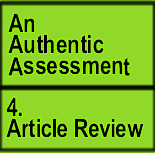Article Review
I chose Johanna Nelís article, "Preventing School Failure: The Native American Child," because I had read Bloodlines by Janet Campbell Hale during the summer and became intrigued with her tale of discrimination, frequent relocations, and her ability to persevere and graduate from high school despite a traumatic childhood. Another reason was due to our literary groupís reading of Ceremony by Leslie Marmo Silke. My last reason arose out of a desire to learn more about the traces of Native American blood in my own family.
I have instructed students from many diverse cultures, but I do not recall having had a Native American student in a class. I became further interested in exploring this culture after reading in GarcŪaís (2002) Student Cultural Diversity about the disconnection between the home culture of Native American students and public school culture. From Nelís article I made some surprising and disheartening discoveries. Native American teenagers have the highest suicide and dropout rate of any minority population (1994, ∂ 1). With these alarming statistics in mind, I decided to begin my presentation with an activity to see how our class compared dominant cultural values to Native American cultural values. When we completed the group activity, I went through the answers for everyone. We then looked at some demographics about Native Americans before looking at some factors that related to underachievement. Outstanding among these differences were the concept of time, unwillingness to compete, aversion to public praise, and the idea of independence.
Native Americans move through life in an unhurried progression, so they are often late for class. Their unwillingness to compete originates from the concept of group cooperation and sharing, which may be viewed by mainstream teachers as unmotivated. Personal praise is regarded as drawing too much attention to oneself, so students may be embarrassed if a teacher praises them in front of the class. Because Native American children are considered independent and capable of making their own choices, they may not inform teachers about the reasons for absences or other personal choices.
To sum up the presentation, I mentioned some of Nelís suggestions to accommodate these differences in the classroom. She emphasized the fact that minority students must be informed about mainstream culture and that they should try to gain an understanding of it. She also pointed out that this does not mean they should reject their home culture but that they should be able to negotiate mainstream culture in order to avoid feelings of isolation and confusion. She suggested that schools offer cultural orientations at the beginning of the school year for parents and students to teach them ways to cope with cultural discomfort and puzzling situations that arise in the school environment.
This presentation also tied in with Grantís (1995) chapter, "The American Indians," a brief history of the major tribes, their languages, and cultures. I did not realize until this semester that they were not granted citizenship until 1924! In Ceremony, a story about a "half-breed" (Native American / White) who served in World War II, the reader experiences the racism and abject life that the protagonist, Tayo, endures after he returns home from the Pacific front. Our guest speaker, Bill Brescia, also offered a similar tale about growing up in Chicago in the 50s and 60s. I can imagine that the same story is repeated in this early part of a new century.
*This is the next step toward THE One World Language.
Step Six: *Your lesson plan on remote control.
Planet Gnosis is ruled by Freddie A. Bowles, a professional educator and fellow at the Department of Curriculum and Instruction, the University of Arkansas at Fayetteville. An independent entity in the CornDancer consortium of planets, Planet Gnosis is dedicated to the exploration of education and teaching. CornDancer is a developmental website for the mind and spirit maintained by webmistress Freddie A. Bowles of the Planet Earth. Submissions are invited.
|





